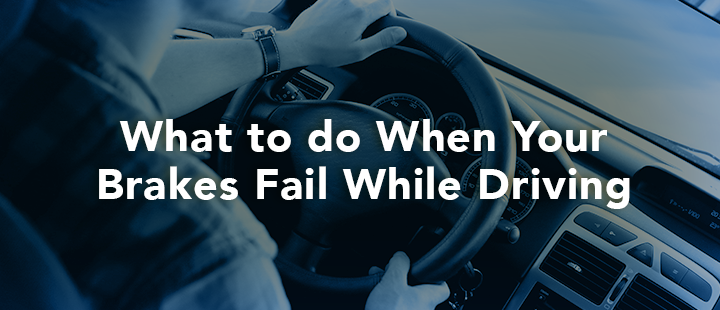What to do When Your Brakes Fail While Driving
For better or worse, driving a car is a hypnotic activity for many people. We’ve become so used to commanding our fast, two-ton, metal vehicles every day on the way to and from work, errands, etc. that we often forget just how dangerous it can be. But nothing snaps you back into cold, hard reality like pressing your brake pedal only to find that it doesn’t work. Here we’ll go over what to do when brakes fail and you’re in a moving vehicle.
Interested in learning more on braking? Check out our blog post, “6 Factors That Contribute to Smooth Braking.”
Keep in Mind What NOT to do
Safely stopping a car without working brakes requires staying calm pressure in order to maintain full control over the vehicle. Keep in mind the following factors.
-
- Do not panic. The next few moments are crucial to your safety and the safety of those around you, so breathe deeply and try to stay clear-headed.
- Don’t downshift too quickly. While you will want to downshift, you shouldn’t go from 4th gear to 1st in an instant. This could cause you to skid out of control.
- Do not turn off the car. Again, this could cause skidding. It also disables power steering or locks the steering wheel entirely, giving you less control over the situation.
- Do not apply the emergency brake too quickly. You will want to apply the emergency brake, but not before downshifting and pumping the brake pedal. Aggressively pulling the emergency brake could cause you to skid and lose control of the vehicle.
What to do When Brakes Fail
- Take your foot off the gas.
- Turn on hazard lights (if you have time). If the roadway is relatively clear and you’re still in full control of the vehicle, turn on your hazard lights and honk your horn to warn others around you. Even if they don’t fully understand your predicament, they will be aware to steer clear of you.
- Downshift SLOWLY. Turn off cruise control (if applicable) and slowly downshift to decrease momentum.
- Pump the brake pedal hard and fast. Most modern vehicles have dual braking systems that independently control the front and back brakes. Pumping the brakes aggressively may be enough to engage half of the brakes to slow you to a halt. This will not work if both halves of the dual system fail.
- Cautiously apply emergency brake. The emergency brake system won’t bring you to a halt, but it will slow you down significantly. Be sure to engage it carefully to ensure you stay in full control.
- (Optional) Use guard rails. If your brakes fail while moving at highway speeds toward unavoidable obstacles, it may be necessary to use the divider or guard rail to scrape the side of your car in order to slow down. When it comes down to it, your life is more important than your car.
- Steer yourself to safety. As the car begins to slow, steer yourself to the side of the road. Coming to a complete stop will be a relief, but you’re putting yourself and others in danger if it’s in the middle of the highway.
Keep a clear head, follow these steps, and stay safe on the road! For more tips and information on all things driving, check out the Top Driver blog or contact Top Driver to learn more about our Illinois, Michigan and Ohio driving programs.
